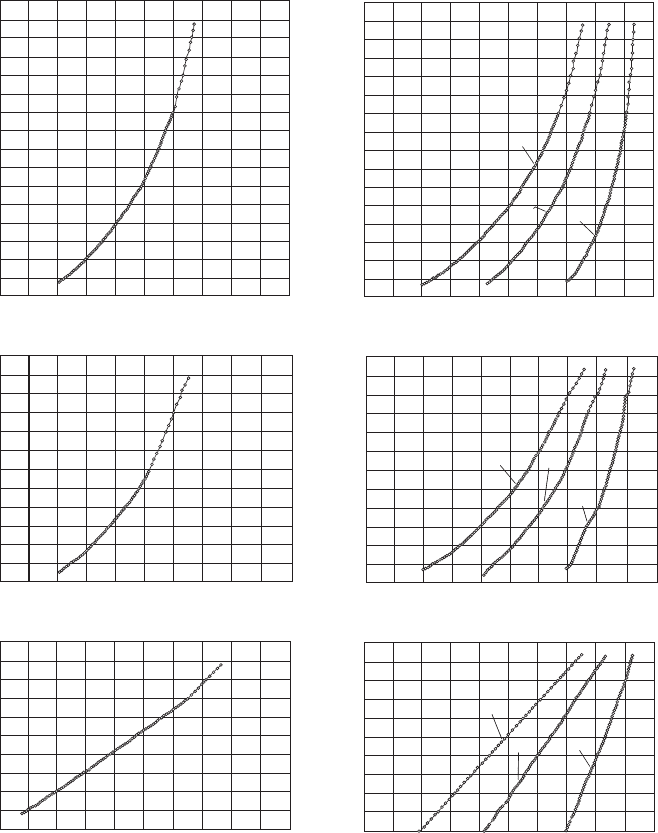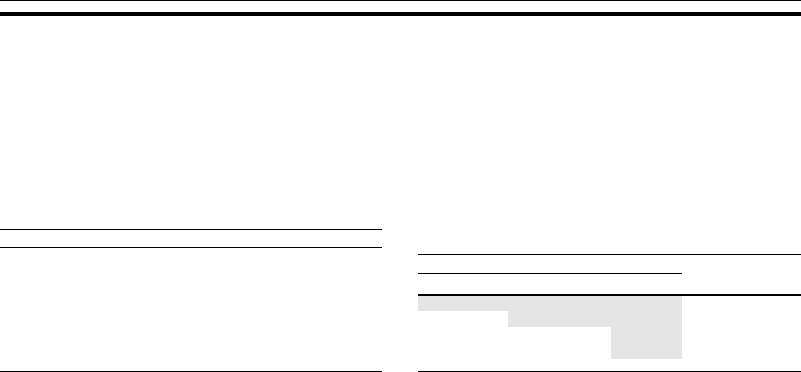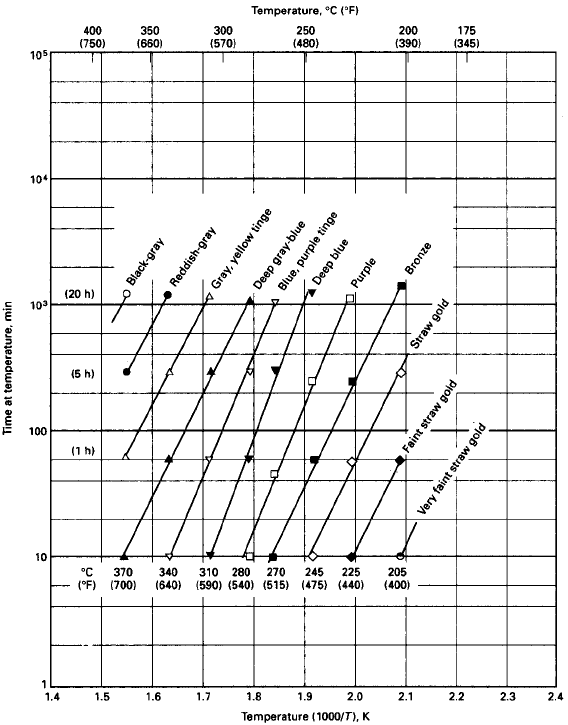Canale L.C.F., Mesquita R.A., Totten G.E. Failure Analysis of Heat Treated Steel Components
Подождите немного. Документ загружается.


Table A3.3 Approximate Rockwell C hardness conversion numbers for nonaustenitic steels, according
to ASTM E140
C, 150 kgf,
diamond
A, 60 kgf,
diamond
D, 100 kgf,
diamond
15 N, 15 kgf,
diamond
30 N, 30 kgf,
diamond
45 N, 45 kgf,
diamond Vickers
Knoop, 500 gf
and over
Brinell, 3000 kgf,
10 mm ball
Tensile strength,
MPa (ksi)
68 85.6 76.9 93.2 84.4 75.4 940 920 ... ...
67 85.0 76.1 92.9 83.6 74.2 900 895 ... ...
66 84.5 75.4 92.5 82.8 73.3 865 870 ... ...
65 83.9 74.5 92.2 81.9 72.0 832 846 739(a) ...
64 83.4 73.8 91.8 81.1 71.0 800 822 722(a) ...
63 82.8 73.0 91.4 80.1 69.9 772 799 705(a) ...
62 82.3 72.2 91.1 79.3 68.8 746 776 688(a) ...
61 81.8 71.5 90.7 78.4 67.7 720 754 670(a) ...
60 81.2 70.7 90.2 77.5 66.6 697 732 654(a) ...
59 80.7 69.9 89.8 76.6 65.5 674 710 634(a) 2420 (351)
58 80.1 69.2 89.3 75.7 64.3 653 690 615 2330 (338)
57 79.6 68.5 88.9 74.8 63.2 633 670 595 2240 (325)
56 79.0 67.7 88.3 73.9 62.0 613 650 577 2158 (313)
55 78.5 66.9 87.9 73.0 60.9 595 630 560 2075 (301)
54 78.0 66.1 87.4 72.0 59.8 577 612 543 2013 (292)
53 77.4 65.4 86.9 71.2 58.6 560 594 525 1951 (283)
52 76.8 64.6 86.4 70.2 57.4 544 576 512 1882 (273)
51 76.3 63.8 85.9 69.4 56.1 528 558 496 1820 (264)
50 75.9 63.1 85.5 68.5 55.0 513 542 481 1758 (255)
49 75.2 62.1 85.0 67.6 53.8 498 526 469 1696 (246)
48 74.7 61.4 84.5 66.7 52.5 484 510 455 1634 (237)
47 74.1 60.8 83.9 65.8 51.4 471 495 443 1579 (229)
46 73.6 60.0 83.5 64.8 50.3 458 480 432 1524 (221)
45 73.1 59.2 83.0 64.0 49.0 446 466 421 1482 (215)
44 72.5 58.5 82.5 63.1 47.8 434 452 409 1434 (208)
43 72.0 57.7 82.0 62.2 46.7 423 438 400 1386 (201)
42 71.5 56.9 81.5 61.3 45.5 412 426 390 1344 (195)
41 70.9 56.2 80.9 60.4 44.3 402 414 381 1296 (188)
40 70.4 55.4 80.4 59.5 43.1 392 402 371 1254 (182)
39 69.9 54.6 79.9 58.6 41.9 382 391 362 1220 (177)
38 69.4 53.8 79.4 57.7 40.8 372 380 353 1179 (171)
37 68.9 53.1 78.8 56.8 39.6 363 370 344 1137 (166)
36 68.4 52.3 78.3 55.9 38.4 354 360 336 1110 (161)
35 67.9 51.5 77.7 55.0 37.2 345 351 327 1075 (156)
34 67.4 50.8 77.2 54.2 36.1 336 342 319 1048 (152)
33 66.8 50.0 76.6 53.3 34.9 327 334 311 1027 (149)
32 66.3 49.2 76.1 52.1 33.7 318 326 301 1006 (146)
31 65.8 48.4 75.6 51.3 32.5 310 318 294 972 (141)
30 65.3 47.7 75.0 50.4 31.3 302 311 286 951 (138)
29 64.8 47.0 74.5 49.5 30.1 294 304 279 930 (135)
28 64.3 46.1 73.9 48.6 28.9 286 297 271 903 (131)
27 63.8 45.2 73.3 47.7 27.8 279 290 264 882 (128)
26 63.3 44.6 72.8 46.8 26.7 272 284 258 861 (125)
25 62.8 43.8 72.2 45.9 25.5 266 278 253 848 (123)
24 62.4 43.1 71.6 45.0 24.3 260 272 247 820 (119)
23 62.0 42.1 71.0 44.0 23.1 254 266 243 806 (117)
22 61.5 41.6 70.5 43.2 22.0 248 261 237 792 (115)
21 61.0 40.9 69.9 42.3 20.7 243 256 231 772 (112)
20 60.5 40.1 69.4 41.5 19.6 238 251 226 758 (110)
Data are only approximate conversions for carbon and low-alloy steels in the annealed, normalized, and quenched-and-tempered conditions; less accurate for cold-worked
condition and for austenitic steels. (a) Hardness values outside the recommended range for Brinell testing per ASTM E10. Source: ASTM E140, except for values for
tensile strength, which are not from standards
Appendix 3: Steel Hardness Conversions / 531
Name ///sr-nova/Dclabs_wip/Failure_Analysis/5113_529-535.pdf/Appendix_3/ 18/8/2008 4:28PM Plate # 0 pg 531

Table A3.4 Approximate equivalent hardness numbers for Brinell hardness numbers for steel
Brinell
indentation
diam, mm
Brinell hardness number(a)
3000 kgf load, 10 mm
ball(a)
Vickers
hardness
No.
Rockwell hardness No.
Rockwell superficial
hardness No.,
diamond indenter
Knoop
hardness No.,
500 gf load
and greater
Scleroscope
hardness No.
Standard
ball
Tungsten-
carbide
ball
A scale,
60 kgf
load,
diamond
indenter
B scale,
100 kgf
load,
1
/
16
in.
diam ball
C scale,
150 kgf
load,
diamond
indenter
D scale,
100 kgf
load,
diamond
indenter
15 N
scale,
15 kgf
load
30 N
scale,
30 kgf
load
45 N
scale,
45 kgf
load
2.25 ... (745) 840 84.1 ... 65.3 74.8 92.3 82.2 72.2 852 91
2.30 ... (712) 783 83.1 ... 63.4 73.4 91.6 80.5 70.4 808 ...
2.35 ... (682) 737 82.2 ... 61.7 72.0 91.0 79.0 68.5 768 84
2.40 ... (653) 697 81.2 ... 60.0 70.7 90.2 77.5 66.5 732 81
2.45 ... 627 667 80.5 ... 58.7 69.7 89.6 76.3 65.1 703 79
2.50 ... 601 640 79.8 ... 57.3 68.7 89.0 75.1 63.5 677 77
2.55 ... 578 615 79.1 ... 56.0 67.7 88.4 73.9 62.1 652 75
2.60 ... 555 591 78.4 ... 54.7 66.7 87.8 72.7 60.6 626 73
2.65 ... 534 569 77.8 ... 53.5 65.8 87.2 71.6 59.2 604 71
2.70 ... 514 547 76.9 ... 52.1 64.7 86.5 70.3 57.6 579 70
2.75 (495) ... 539 76.7 ... 51.6 64.3 86.3 69.9 56.9 571 ...
... 495 528 76.3 ... 51.0 63.8 85.9 69.4 56.1 558 68
2.80 (477) ... 516 75.9 ... 50.3 63.2 85.6 68.7 55.2 545 ...
... 477 508 75.6 ... 49.6 62.7 85.3 68.2 54.5 537 66
2.85 (461) ... 495 75.1 ... 48.8 61.9 84.9 67.4 53.5 523 ...
... 461 491 74.9 ... 48.5 61.7 84.7 67.2 53.2 518 65
2.90 444 ... 474 74.3 ... 47.2 61.0 84.1 66.0 51.7 499 ...
... 444 472 74.2 ... 47.1 60.8 84.0 65.8 51.5 496 63
2.95 429 429 455 73.4 ... 45.7 59.7 83.4 64.6 49.9 476 61
3.00 415 415 440 72.8 ... 44.5 58.8 82.8 63.5 48.4 459 59
3.05 401 401 425 72.0 ... 43.1 57.8 82.0 62.3 46.9 441 58
3.10 388 388 410 71.4 ... 41.8 56.8 81.4 61.1 45.3 423 56
3.15 375 375 396 70.6 ... 40.4 55.7 80.6 59.9 43.6 407 54
3.20 363 363 383 70.0 ... 39.1 54.6 80.0 58.7 42.0 392 52
3.25 352 352 372 69.3 (110.0) 37.9 53.8 79.3 57.6 40.5 379 51
3.30 341 341 360 68.7 (109.0) 36.6 52.8 78.6 56.4 39.1 367 50
3.35 331 331 350 68.1 (108.5) 35.5 51.9 78.0 55.4 37.8 356 48
3.40 321 321 339 67.5 (108.0) 34.3 51.0 77.3 54.3 36.4 345 47
3.45 311 311 328 66.9 (107.5) 33.1 50.0 76.7 53.3 34.4 336 46
3.50 302 302 319 66.3 (107.0) 32.1 49.3 76.1 52.2 33.8 327 45
3.55 293 293 309 65.7 (106.0) 30.9 48.3 75.5 51.2 32.4 318 43
3.60 285 285 301 65.3 (105.5) 29.9 47.6 75.0 50.3 31.2 310 42
3.65 277 277 292 64.6 (104.5) 28.8 46.7 74.4 49.3 29.9 302 41
3.70 269 269 284 64.1 (104.0) 27.6 45.9 73.7 48.3 28.5 294 40
3.75 262 262 276 63.6 (103.0) 26.6 45.0 73.1 47.3 27.3 286 39
3.80 255 255 269 63.0 (102.0) 25.4 44.2 72.5 46.2 26.0 279 38
3.85 248 248 261 62.5 (101.0) 24.2 43.2 71.7 45.1 24.5 272 37
3.90 241 241 253 61.8 100.0 22.8 42.0 70.9 43.9 22.8 265 36
3.95 235 235 247 61.4 99.0 21.7 41.4 70.3 42.9 21.5 259 35
4.00 229 229 241 60.8 98.2 20.5 40.5 69.7 41.9 20.1 253 34
4.05 223 223 234 ... 97.3 (19.0) ... ... ... ... 247 ...
4.10 217 217 228 ... 96.4 (17.7) ... ... ... ... 242 33
4.15 212 212 222 ... 95.5 (16.4) ... ... ... ... 237 32
4.20 207 207 218 ... 94.6 (15.2) ... ... ... ... 232 31
4.25 201 201 212 ... 93.7 (13.8) ... ... ... ... 227 ...
4.30 197 197 207 ... 92.8 (12.7) ... ... ... ... 222 30
4.35 192 192 202 ... 91.9 (11.5) ... ... ... ... 217 29
4.40 187 187 196 ... 90.9 (10.2) ... ... ... ... 212 ...
4.45 183 183 192 ... 90.0 (9.0) ... ... ... ... 207 28
4.50 179 179 188 ... 89.0 (8.0) ... ... ... ... 202 27
4.55 174 174 182 ... 88.0 (6.7) ... ... ... ... 198 ...
4.60 170 170 178 ... 87.0 (5.4) ... ... ... ... 194 26
4.65 167 167 175 ... 86.0 (4.4) ... ... ... ... 190 ...
4.70 163 163 171 ... 85.0 (3.3) ... ... ... ... 186 25
4.75 159 159 167 ... 83.9 (2.0) ... ... ... ... 182 ...
4.80 156 156 163 ... 82.9 (0.9) ... ... ... ... 178 24
(continued)
Note: Values in parentheses are beyond normal range and are given for information only. Data are for carbon and alloy steels in the annealed, normalized, and quenched-
and-tempered conditions; less accurate for cold-worked condition and for austenitic steels (a) Brinell numbers are based on the diameter of impressed indentation. If the
ball distorts (flattens) during test, Brinell numbers will vary in accordance with the degree of such distortion when related to hardnesses determined with a Vickers diamond
pyramid. Rockwell diamond indenter, or other indenter that does not sensibly distort. At high hardnesses, therefore, the relationship between Brinell and Vickers or
Rockwell scales is affected by the type of ball used. Standard steel balls tend to flatten slightly moe than tungsten-carbide balls, resulting in a larger indentation and a lower
Brinell number than shown by a tungsten carbide ball. Thus, on a specimen of about 539–547 HV, a standard ball will leave a 2.75 mm indentation (495 HB), and a
tungsten carbide ball a 2.70 mm indentation (514 HB). Conversely, identical indentation diameters for both types of ball will correspond to different Vickers and
Rockwell values. Thus, if indentation in two different specimens both are 2.75 mm diameter (495 HB), the specimen tested with a standard ball has a Vickers hardness of
539, whereas the specimen tested with a tungsten-carbide ball has a Vickers hardness of 528. Source: ASTM E140
532 / Failure Analysis of Heat Treated Steel Components
Name ///sr-nova/Dclabs_wip/Failure_Analysis/5113_529-535.pdf/Appendix_3/ 18/8/2008 4:28PM Plate # 0 pg 532

Table A3.4 (continued)
Brinell
indentation
diam, mm
Brinell hardness number(a)
3000 kgf load, 10 mm
ball(a)
Vickers
hardness
No.
Rockwell hardness No.
Rockwell superficial
hardness No.,
diamond indenter
Knoop
hardness No.,
500 gf load
and greater
Scleroscope
hardness No.
Standard
ball
Tungsten-
carbide
ball
A scale,
60 kgf
load,
diamond
indenter
B scale,
100 kgf
load,
1
/
16
in.
diam ball
C scale,
150 kgf
load,
diamond
indenter
D scale,
100 kgf
load,
diamond
indenter
15 N
scale,
15 kgf
load
30 N
scale,
30 kgf
load
45 N
scale,
45 kgf
load
4.85 152 152 159 ... 81.9 ... ... ... ... ... 174 ...
4.90 149 149 156 ... 80.8 ... ... ... ... ... 170 23
4.95 146 146 153 ... 79.7 ... ... ... ... ... 166 ...
5.00 143 143 150 ... 78.6 ... ... ... ... ... 163 22
5.10 137 137 143 ... 76.4 ... ... ... ... ... 157 21
5.20 131 131 137 ... 74.2 ... ... ... ... ... 151 ...
5.30 126 126 132 ... 72.0 ... ... ... ... ... 145 20
5.40 121 121 127 ... 69.8 ... ... ... ... ... 140 19
5.50 116 116 122 ... 67.6 ... ... ... ... ... 135 18
5.60 111 111 117 ... 65.4 ... ... ... ... ... 131 17
Note: Values in parentheses are beyond normal range and are given for information only. Data are for carbon and alloy steels in the annealed, normalized, and quenched-
and-tempered conditions; less accurate for cold-worked condition and for austenitic steels (a) Brinell numbers are based on the diameter of impressed indentation. If the
ball distorts (flattens) during test, Brinell numbers will vary in accordance with the degree of such distortion when related to hardnesses determined with a Vickers diamond
pyramid. Rockwell diamond indenter, or other indenter that does not sensibly distort. At high hardnesses, therefore, the relationship between Brinell and Vickers or
Rockwell scales is affected by the type of ball used. Standard steel balls tend to flatten slightly moe than tungsten-carbide balls, resulting in a larger indentation and a lower
Brinell number than shown by a tungsten carbide ball. Thus, on a specimen of about 539–547 HV, a standard ball will leave a 2.75 mm indentation (495 HB), and a
tungsten carbide ball a 2.70 mm indentation (514 HB). Conversely, identical indentation diameters for both types of ball will correspond to different Vickers and
Rockwell values. Thus, if indentation in two different specimens both are 2.75 mm diameter (495 HB), the specimen tested with a standard ball has a Vickers hardness of
539, whereas the specimen tested with a tungsten-carbide ball has a Vickers hardness of 528. Source: ASTM E140
Table A3.5 Approximate equivalent hardness numbers for Vickers (diamond pyramid) hardness
numbers for steel
Vickers
hardness
No.
Brinell hardness No.,
3000 kg load,
10 mm ball
Rockwell hardness No.
Rockwell superficial
(diamond pyramid)
hardness No.,
diamond indenter
Knoop
hardness No.,
500 gf load
and greater
Scleroscope
hardness
No.
Standard
ball
Tungsten-
carbide
ball
A scale,
60 kgf
load,
diamond
indenter
B scale,
100 kgf
load,
1
/
16
in.
diam ball
C scale,
150 kgf
load,
diamond
indenter
D scale,
100 kgf
load,
diamond
indenter
15 N scale,
15 kgf
load
30 N scale,
30 kgf
load
45 N scale,
45 kgf
load
940 ... ... 85.6 ... 68.0 76.9 93.2 84.4 75.4 920 97
920 ... ... 85.3 ... 67.5 76.5 93.0 84.0 74.8 908 96
900 ... ... 85.0 ... 67.0 76.1 92.9 83.6 74.2 895 95
880 ... (767) 84.7 ... 66.4 75.7 92.7 83.1 73.6 882 93
860 ... (757) 84.4 ... 65.9 75.3 92.5 82.7 73.1 867 92
840 ... (745) 84.1 ... 65.3 74.8 92.3 82.2 72.2 852 91
820 ... (733) 83.8 ... 64.7 74.3 92.1 81.7 71.8 837 90
800 ... (722) 83.4 ... 64.0 73.8 91.8 81.1 71.0 822 88
780 ... (710) 83.0 ... 63.3 73.3 91.5 80.4 70.2 806 87
760 ... (698) 82.6 ... 62.5 72.6 91.2 79.7 69.4 788 86
740 ... (684) 82.2 ... 61.8 72.1 91.0 79.1 68.6 772 84
720 ... (670) 81.8 ... 61.0 71.5 90.7 78.4 67.7 754 83
700 ... (656) 81.3 ... 60.1 70.8 90.3 77.6 66.7 735 81
690 ... (647) 81.1 ... 59.7 70.5 90.1 77.2 66.2 725 ...
680 ... (638) 80.8 ... 59.2 70.1 89.8 76.8 65.7 716 80
670 ... (630) 80.6 ... 58.8 69.8 89.7 76.4 65.3 706 ...
660 ... 620 80.3 ... 58.3 69.4 89.5 75.9 64.7 697 79
650 ... 611 80.0 ... 57.8 69.0 89.2 75.5 64.1 687 78
640 ... 601 79.8 ... 57.3 68.7 89.0 75.1 63.5 677 77
630 ... 591 79.5 ... 56.8 68.3 88.8 74.6 63.0 667 76
620 ... 582 79.2 ... 56.3 67.9 88.5 74.2 62.4 657 75
610 ... 573 78.9 ... 55.7 67.5 88.2 73.6 61.7 646 ...
600 ... 564 78.6 ... 55.2 67.0 88.0 73.2 61.2 636 74
590 ... 554 78.4 ... 54.7 66.7 87.8 72.7 60.5 625 73
580 ... 545 78.0 ... 54.1 66.2 87.5 72.1 59.9 615 72
570 ... 535 77.8 ... 53.6 65.8 87.2 71.7 59.3 604 ...
(continued)
Note: Values in parentheses are beyond normal range and are given for information only. Data are for carbon and alloy steels in the annealed, normalized, and quenched-
and-tempered conditions; less accurate for cold-worked condition and for austenitic steels. Source: ASTM E140
Appendix 3: Steel Hardness Conversions / 533
Name ///sr-nova/Dclabs_wip/Failure_Analysis/5113_529-535.pdf/Appendix_3/ 18/8/2008 4:28PM Plate # 0 pg 533

Table A3.5 (continued)
Vickers
hardness
No.
Brinell hardness No.,
3000 kg load,
10 mm ball
Rockwell hardness No.
Rockwell superficial
(diamond pyramid)
hardness No.,
diamond indenter
Knoop
hardness No.,
500 gf load
and greater
Scleroscope
hardness
No.
Standard
ball
Tungsten-
carbide
ball
A scale,
60 kgf
load,
diamond
indenter
B scale,
100 kgf
load,
1
/
16
in.
diam ball
C scale,
150 kgf
load,
diamond
indenter
D scale,
100 kgf
load,
diamond
indenter
15 N scale,
15 kgf
load
30 N scale,
30 kgf
load
45 N scale,
45 kgf
load
560 ... 525 77.4 ... 53.0 65.4 86.9 71.2 58.6 594 71
550 (505) 517 77.0 ... 52.3 64.8 86.6 70.5 57.8 583 70
540 (496) 507 76.7 ... 51.7 64.4 86.3 70.0 57.0 572 69
530 (488) 497 76.4 ... 51.1 63.9 86.0 69.5 56.2 561 68
520 (480) 488 76.1 ... 50.5 63.5 85.7 69.0 55.6 550 67
510 (473) 479 75.7 ... 49.8 62.9 85.4 68.3 54.7 539 ...
500 (465) 471 75.3 ... 49.1 62.2 85.0 67.7 53.9 528 66
490 (456) 460 74.9 ... 48.4 61.6 84.7 67.1 53.1 517 65
480 (448) 452 74.5 ... 47.7 61.3 84.3 66.4 52.2 505 64
470 441 442 74.1 ... 46.9 60.7 83.9 65.7 51.3 494 ...
460 433 433 73.6 ... 46.1 60.1 83.6 64.9 50.4 482 62
450 425 425 73.3 ... 45.3 59.4 83.2 64.3 49.4 471 ...
440 415 415 72.8 ... 44.5 58.8 82.8 63.5 48.4 459 59
430 405 405 72.3 ... 43.6 58.2 82.3 62.7 47.4 447 58
420 397 397 71.8 ... 42.7 57.5 81.8 61.9 46.4 435 57
410 388 388 71.4 ... 41.8 56.8 81.4 61.1 45.3 423 56
400 379 379 70.8 ... 40.8 56.0 80.8 60.2 44.1 412 55
390 369 369 70.3 ... 39.8 55.2 80.3 59.3 42.9 400 ...
380 360 360 69.8 (110.0) 38.8 54.4 79.8 58.4 41.7 389 52
370 350 350 69.2 ... 37.7 53.6 79.2 57.4 40.4 378 51
360 341 341 68.7 (109.0) 36.6 52.8 78.6 56.4 39.1 367 50
350 331 331 68.1 ... 35.5 51.9 78.0 55.4 37.8 356 48
340 322 322 67.6 (108.0) 34.4 51.1 77.4 54.4 36.5 346 47
330 313 313 67.0 ... 33.3 50.2 76.8 53.6 35.2 337 46
320 303 303 66.4 (107.0) 32.2 49.4 76.2 52.3 33.9 328 45
310 294 294 65.8 ... 31.0 48.4 75.6 51.3 32.5 318 ...
300 284 284 65.2 (105.5) 29.8 47.5 74.9 50.2 31.1 309 42
295 280 280 64.8 ... 29.2 47.1 74.6 49.7 30.4 305 ...
290 275 275 64.5 (104.5) 28.5 46.5 74.2 49.0 29.5 300 41
285 270 270 64.2 ... 27.8 46.0 73.8 48.4 28.7 296 ...
280 265 265 63.8 (103.5) 27.1 45.3 73.4 47.8 27.9 291 40
275 261 261 63.5 ... 26.4 44.9 73.0 47.2 27.1 286 39
270 256 256 63.1 (102.0) 25.6 44.3 72.6 46.4 26.2 282 38
265 252 252 62.7 ... 24.8 43.7 72.1 45.7 25.2 277 ...
260 247 247 62.4 (101.0) 24.0 43.1 71.6 45.0 24.3 272 37
255 243 243 62.0 ... 23.1 42.2 71.1 44.2 23.2 267 ...
250 238 238 61.6 99.5 22.2 41.7 70.6 43.4 22.2 262 36
245 233 233 61.2 ... 21.3 41.1 70.1 42.5 21.1 258 35
240 228 228 60.7 98.1 20.3 40.3 69.6 41.7 19.9 253 34
230 219 219 ... 96.7 (18.0) ... ... ... ... 243 33
220 209 209 ... 95.0 (15.7) ... ... ... ... 234 32
210 200 200 ... 93.4 (13.4) ... ... ... .... 226 30
200 190 190 ... 91.5 (11.0) ... ... ... ... 216 29
190 181 181 ... 89.5 ( 8.5) ... ... ... ... 206 28
180 171 171 ... 87.1 (6.0) ... ... ... ... 196 26
170 162 162 ... 85.0 (3.0) ... ... ... ... 185 25
160 152 152 ... 81.7 (0.0) ... ... ... ... 175 23
150 143 143 ... 78.7 ... ... ... ... ... 164 22
140 133 133 ... 75.0 ... ... ... ... ... 154 21
130 124 124 ... 71.2 ... ... ... ... ... 143 20
120 114 114 ... 66.7 ... ... ... ... ... 133 18
110 105 105 ... 62.3 ... ... ... ... ... 123 ...
100 95 95 ... 56.2 ... ... ... ... ... 112 ...
95 90 90 ... 52.0 ... ... ... ... ... 107 ...
90 86 86 ... 48.0 ... ... ... ... ... 102 ...
85 81 81 ... 41.0 ... ... ... ... ... 97 ...
Note: Values in parentheses are beyond normal range and are given for information only. Data are for carbon and alloy steels in the annealed, normalized, and quenched-
and-tempered conditions; less accurate for cold-worked condition and for austenitic steels. Source: ASTM E140
534 / Failure Analysis of Heat Treated Steel Components
Name ///sr-nova/Dclabs_wip/Failure_Analysis/5113_529-535.pdf/Appendix_3/ 18/8/2008 4:28PM Plate # 0 pg 534

200
300
400
500
600
700
800
900
1000
Vickers hardness
0 102030405060708090100
Rockwell superficial hardness number
45 N
30 N
15 N
200
300
400
500
600
700
800
Brinell hardness number
0
10 20 30 40 50 60 70 80 90
100
200
300
400
500
600
700
800
Brinell hardness number
0
10 20 30 40 50 60 70 80 90
100
0
0
200
400
600
800
1000
100 200 300 400 500 600 700 900800
1000
20
0
30
40
50
60
70
10 20 30 40 50 60 70 9080
100
45 N
45 N
30 N
15 N
30 N
15 N
Brinell hardness number Rockwell superficial hardness number
Rockwell superficial hardness number
Rockwell C hardness
200
300
400
500
600
700
800
900
1000
Vickers hardness
0102030405060708090100
Rockwell C hardness
Vickers hardness
Rockwell C hardness
Fig. A3.1 Approximate equivalent hardness numbers for steel. Points represent data from the hardness conversion tables.
Appendix 3: Steel Hardness Conversions / 535
Name ///sr-nova/Dclabs_wip/Failure_Analysis/5113_529-535.pdf/Appendix_3/ 18/8/2008 4:28PM Plate # 0 pg 535

APPENDIX 4
Austenitizing Temperatures for Steels
TEMPERATURES RECOMMENDED for
austenitizing carbon and low-alloy steels prior
to hardening are given in Table A4.1 (for
direct-hardening grades) and Table A4.2 (for
carburized steels). Table A4.2 is applicable to
carburized steels that have been cooled slowly
from the carburizing temperature and are to be
furnace hardened in a subsequent operation.
For most applications, the rate of heating to
the austenitizing temperature is less important
than other factors in the hardening process, such
as maximum temperature attained throughout
the section, temperature uniformity, time at
temperature, and rate of cooling. The thermal
conductivity of the steel, the nature of the
furnace atmosphere (scaling or nonscaling),
thickness of section, method of loading (spaced
or stacked), and the degree of circulation of
the furnace atmosphere all influence the rate of
heating of the steel part to the required tem-
perature selected from Tables A4.1 and A4.2.
The difference in temperature rise within
thick and thin sections of articles of varying
cross section is a major problem in practical
heat-treating operations. When temperature
uniformity is the ultimate objective of the heat-
ing cycle, this is more safely attained by slowly
heating than by rapidly heating. Furthermore,
the maximum temperat ure in the austenite range
should not exceed that required to achieve
the necessary extent of solution of carbide. The
temperatures listed in Tables A4.1 and A4.2
conform with this requirement. When heating
with significant cross-section variations, provi-
sions should be made for slower heating to
minimize thermal stresses and distortions.
Table A4.1 Austenitizing temperatures for direct-hardening carbon and alloy steels (SAE)
Steel
Temperature
°C °F
Carbon steels
1025 855–900 1575–1650
1030 845–870 1550–1600
1035 830–855 1525–1575
1037 830–855 1525–1575
1038(a) 830–855 1525–1575
1039(a) 830–855 1525–1575
1040(a) 830–855 1525–1575
1042 800–845 1475–1550
1043(a) 800–845 1475–1550
1045(a) 800–845 1475–1550
1046(a) 800–845 1475–1550
1050(a) 800–845 1475–1550
1055 800–845 1475–1550
1060 800–845 1475–1550
1065 800–845 1475–1550
1070 800–845 1475–1550
1074 800–845 1475–1550
1078 790–815 1450–1500
1080 790–815 1450–1500
1084 790–815 1450–1500
1085 790–815 1450–1500
1086 790–815 1450–1500
1090 790–815 1450–1500
1095 790–815(a) 1450–1500(b)
Steel
Temperature
°C °F
Free-cutting carbon steels
1137 830–855 1525–1575
1138 815–845 1500–1550
1140 815–845 1500–1550
1141 800–845 1475–1550
1144 800–845 1475–1550
1145 800–845 1475–1550
1146 800–845 1475–1550
1151 800–845 1475–1550
1536 815–845 1500–1550
1541 815–845 1500–1550
1548 815–845 1500–1550
1552 815–845 1500–1550
1566 855–885 1575–1625
Alloy steels
1330 830–855 1525–1575
1335 815–845 1500–1550
1340 815–845 1500–1550
1345 815–845 1500–1550
3140 815–845 1500–1550
4037 830–855 1525–1575
4042 830–855 1525–1575
4047 815–855 1500–1575
(continued)
(a) Commonly used on parts where induction hardening is employed. All steels from SAE 1030 up may have induction hardening applications. (b) This temperature range
may be employed for 1095 steel that is to be quenched in water, brine, or oil. For oil quenching, 1095 steel may alternatively be austenitized in the range 815 to 870
C
(1500 to 1600
F). (c) This range is recommended for steel that is to be water quenched. For oil quenching, steel should be austenitized in the range 815 to 870
C (1500 to
1600
F).
Name ///sr-nova/Dclabs_wip/Failure_Analysis/5113_537-538.pdf/Appendix_4/ 18/8/2008 4:29PM Plate # 0 pg 537
Failure Analysis of Heat Treated Steel Components
L.C.F. Canale, R.A. Mesquita, and G.E. Totten, editors, p 537-538
DOI: 10.1361/faht2008p537
Copyright © 2008 ASM International®
All rights reserved.
www.asminternational.org

Table A4.2 Reheating (austenitizing) temperatures for hardening of carburized carbon and alloy
steels (SAE)
Carburizing is commonly carried out at 900 to 925
C (1650 to 1700
F); slow cooled and reheated to given austenizing temperature.
Steel
Temperature
°C °F
Carbon steels
1010 760–790 1400–1450
1012 760–790 1400–1450
1015 760–790 1400–1450
1016 760–790 1400–1450
1017 760–790 1400–1450
1018 760–790 1400–1450
1019 760–790 1400–1450
1020 760–790 1400–1450
1022 760–790 1400–1450
1513 760–790 1400–1450
1518 760–790 1400–1450
1522 760–790 1400–1450
1524 760–790 1400–1450
1525 760–790 1400–1450
1526 760–790 1400–1450
1527 760–790 1400–1450
Free-cutting carbon steels
1109 760–790 1400–1450
1115 760–790 1400–1450
1117 760–790 1400–1450
1118 760–790 1400–1450
Steel
Temperature
°C °F
Alloy steels
3310 790–830 1450–1525
4320 830–845 1525–1550
4615 815–845 1500–1550
4617 815–845 1500–1550
4620 815–845 1500–1550
4621 815–845 1500–1550
4626 815–845 1500–1550
4718 815–845 1500–1550
4720 815–845 1500–1550
4815 800–830 1475–1525
4817 800–830 1475–1525
4820 800–830 1475–1525
8115 845–870 1550–1600
8615 845–870 1550–1600
8617 845–870 1550–1600
8620 845–870 1550–1600
8622 845–870 1550–1600
8625 845–870 1550–1600
8627 845–870 1550–1600
8720 845–870 1550–1600
8822 845–870 1550–1600
9310 790–830 1450–1525
Table A4.1 (continued)
Steel
Temperature
°C °F
4063 800–845 1475–1550
4130 815–870 1500–1600
4135 845–870 1550–1600
4137 845–870 1550–1600
4140 845–870 1550–1600
4142 845–870 1550–1600
4145 815–845 1500–1550
4147 815–845 1500–1550
4150 815–845 1500–1550
4161 815–845 1500–1550
4337 815–845 1500–1550
4340 815–845 1500–1550
50B40 815–845 1500–1550
50B44 815–845 1500–1550
5046 815–845 1500–1550
50B46 815–845 1500–1550
50B50 800–845 1475–1550
50B60 800–845 1475–1550
5130 830–855 1525–1575
5132 830–855 1525–1575
5135 815–845 1500–1550
5140 815–845 1500–1550
5145 815–845 1500–1550
5147 800–845 1475–1550
5150 800–845 1475–1550
Steel
Temperature
°C °F
5155 800–845 1475–1550
5160 800–845 1475–1550
51B60 800–845 1475–1550
50100 775–800(c) 1425–1475(c)
51100 775–800(c) 1425–1475(c)
52100 775–800(c) 1425–1475(c)
6150 845–885 1550–1625
81B45 815–855 1500–1575
8630 830–870 1525–1600
8637 830–855 1525–1575
8640 830–855 1525–1575
8642 815–855 1500–1575
8645 815–855 1500–1575
86B45 815–855 1500–1575
8650 815–855 1500–1575
8655 800–845 1475–1550
8660 800–845 1475–1550
8740 830–855 1525–1575
8742 830–855 1525–1575
9254 815–900 1500–1650
9255 815–900 1500–1650
9260 815–900 1500–1650
94B30 845–885 1550–1625
94B40 845–885 1550–1625
9840 830–855 1525–1575
(a) Commonly used on parts where induction hardening is employed. All steels from SAE 1030 up may have induction hardening applications. (b) This temperature range
may be employed for 1095 steel that is to be quenched in water, brine, or oil. For oil quenching, 1095 steel may alternatively be austenitized in the range 815 to 870
C
(1500 to 1600
F). (c) This range is recommended for steel that is to be water quenched. For oil quenching, steel should be austenitized in the range 815 to 870
C (1500 to
1600
F).
538 / Failure Analysis of Heat Treated Steel Components
Name ///sr-nova/Dclabs_wip/Failure_Analysis/5113_537-538.pdf/Appendix_4/ 18/8/2008 4:30PM Plate # 0 pg 538

APPENDIX 5
Temper Colors for Steels
IT IS COMMON and long-time knowledge
that steel heated in contact with air at tempera-
tures in the tempering range takes on various
temper colors due to the formation of a thin oxide
film. As an example, the 1948 ASM Metals
Handbook gives the following table:
Heating temperature, °F Color
400 Faint straw
440 Straw
475 Deep straw
520 Bronze
540 Peacock
590 Full blue
640 Light blue
Color Chart (back cover). Another exam-
ple of temper colors is shown on the back cover
of this book. This example was developed to
illustrate the effect of oxidation with furnace
leaks. Oxidation of steel in the front of a con-
tinuous furnace results in a frosted or matt sur-
face finish with a loss of surface brightness.
Oxidation in the high heat section is evidenced
by a black oxide that is often scaled and flakes
from the surface of the steel. If oxidation is
occurring in the cooling section of a continuous
furnace, use the following test to determine the
cause:
Copper/Steel/Stainless Steel Test.
Change the atmosphere flow in the furnace
to 100% Nitrogen
Make absolutely sure that every zone of the
furnace is below 1900
F to prevent copper
from melting
Place a piece of bright copper strip, a bright
carbon steel strip and a bright stainless steel
strip side by side on the belt and send them
through the furnace.
Use the following chart to determine the
source of oxidation and the color chart to
determine its location:
Sample surface appearance
ConclusionsCopper Carbon steel Stainless steel
Oxidized Oxidized Oxidized Air leak
Bright Oxidized Oxidized Water leak
Bright Bright Oxidized Very small air
Or water leak
Time-Temperature Effect. A study at the
Illinois Institute of Technology obtained de-
tailed information on temper colors for plain
carbon steel, especially on the effect of time and
temperature. This was obtained using 16 mm
(5/8 in.) diam hot-rolled bars of a standard SAE
1035 steel. Samples that were 50 mm (2 in.)
long were cut from the bars and carefully
machined and cleaned to give smooth, bright
surfaces. They were then heated for various
times at several temperatures in air-circulating
furnaces controlled to within +3
C(+5
F)
of the desired temperatures. The results of this
study are shown in Fig. A5.1 for 1035 steel.
Name ///sr-nova/Dclabs_wip/Failure_Analysis/5113_539-540.pdf/Appendix-5/ 18/8/2008 4:30PM Plate # 0 pg 539
Failure Analysis of Heat Treated Steel Components
L.C.F. Canale, R.A. Mesquita, and G.E. Totten, editors, p 539-540
DOI: 10.1361/faht2008p539
Copyright © 2008 ASM International®
All rights reserved.
www.asminternational.org

Fig. A5.1 Temper colors after heating 1035 steel in circulating air (atmosphe ric pressure)
540 / Failure Analysis of Heat Treated Steel Components
Name ///sr-nova/Dclabs_wip/Failure_Analysis/5113_539-540.pdf/Appendix-5/ 18/8/2008 4:30PM Plate # 0 pg 540

APPENDIX 6
Physical Properties of Carbon
and Low-Alloy Steels
Thermal Expansion
Table A6.1 Coefficients of linear thermal expansion for carbon and low-alloy steels
AISI-SAE
grade Treatment or condition
Average coefficient of expansion, mm/m K, at °C(°F)(a)
20–100
(68–212)
20–200
(68–392)
20–300
(68–572)
20–400
(68–752)
20–500
(68–932)
20–600
(68–1112)
20–700
(68–1292)
1008 Annealed 12.6(b) 13.1(b) 13.5(b) 13.8(b ) 14.2(b) 14.6(b) 15.0(b)
1008 Annealed 11.6 12.5 13.0 13.6 14.2 14.6 15.0
1010 Annealed 12.2(b) 13.0(b) 13.5(b) 13.9(b ) 14.3(b) 14.7(b) 15.0(b)
1010 Unknown 11.9(c) 12.6 13.3 13.8 14.3 14.7 14.9
1010 Unknown ... ... ... 15.1(d) ... ... ...
1015 Rolled 11.9(b) 12.5(b) 13.0(b) 13.6(b) 14.2(b) ... ...
1015 Annealed 12.2(b) ... ... 13.4(b) ... 14.2(b) ...
1016 Annealed 12.0(b) ... ... 13.5(b) ... 14.4(b) ...
1017 Unknown 12.2(b) ... ... 13.5(b) ... 14.5(b) ...
1018 Annealed 12.0(b) ... ... 13.5(b) ... 14.4(b) ...
1019 Unknown 12.2(b) ... ... 13.5(b) ... 14.7(b) ...
1020 Annealed 11.7 12.1 12.8 13.4 13.9 14.4 14.8
1020 Unknown 12.2(b) ... ... 13.5(b) ... 14.2(b) ...
1021 Unknown 12.0(b) ... ... 13.5(b) ... 14.3(b) ...
1022 Annealed 12.2(b) 12.7(b) 13.1(b) 13.5(b ) 13.9(b) 14.4(b) 14.9(b)
1023 Unknown 12.2(b) ... ... 13.5(b) ... 14.4(b) ...
1025 Annealed 12.0(b) ... ... 13.5(b) ... 14.4(b) ...
1026 Annealed 12.0(b) ... ... 13.5(b) ... 14.4(b) ...
1029 Annealed 12.0(b) ... ... 13.5(b) ... 14.4(b) ...
1030 Annealed 11.7(b) ... ... 13.5(b) ... 14.4(b) ...
1035 Annealed 11.1 11.9 12.7 13.4 14.0 14.4 14.8
1037 Annealed 11.1(b) ... ... 13.5(b) ... 14.6(b) ...
1039 Annealed 11.1(b) ... ... 13.5(b) ... 14.6(b) ...
1040 Annealed 11.3 12.0 12.5 13.3 13.9 14.4 14.8
1043 Annealed 11.3(b) ... ... 13.5(b) ... 14.6(b) ...
1044 Annealed 11.1(b) 12.0(b) ... 13.3(b) ... ... ...
1045 Annealed 11.6(b) 12.3(b) 13.1(b) 13.7(b ) 14.2(b) 14.7(b) 15.1(b)
1045 Annealed 11.2(e) 11.9(e) 12.7(e) 13.5(e) 14.1(e) 14.5(e) 14.8(e)
1046 Unknown 11.1(b) ... ... 13.5(b) ... ... ...
1050 Annealed 11.1(b) 12.0(b) ... 13.5(b) ... ... ...
1052 Annealed 11.3(e) 11.8(e) 12.7(e) 13.7(e) 14.5(e) 14.7(e) 15.0(e)
1053 Unknown 11.1(b) ... ... 13.5(b) ... ... ...
1055 Annealed 11.0 11.8 12.6 13.4 14.0 14.5 14.8
1060 Annealed 11.1(e) 11.9(e) 12.9(e) 13.5(e) 14.1(e) 14.6(e) 14.9(e)
(continued)
(a) To obtain coefficients in min./in.
F, multiply stated values by 0.556. (b) Stated value represents average coefficient between 0
C (32
F) and indicated temperature.
(c) 10.3 mm/m K from 100 to 20
C(148 to 68
F); 9.8 mm/m K from 150 to 20
C(238 to 68
F). (d) Stated value represents average coefficient between 20
and 650
C (68 and 1200
F). (e) Stated value represents average coefficient between 25
C (75
F) and indicated temperature. (f) Stated value represents average
coefficient between 20 and 95
C (68 and 200
F). (g) Stated value represents average coefficient between 20 and 370
C (68 and 700
F). (h) 8.6 mm/m K from 195 to
20
C(320 to 68
F); 10.0 mm/m K from 130 to 20
C(200 to 68
F). (i) Stated value represents average coefficient between 20 and 260
C (68 and 500
F).
(j) Stated value represents average coefficient between 20 and 540
C (68 and 1000
F). (k) Stated value represents average coefficient between 18 and 95
C (0 and
200
F). (l) Stated value represents average coefficient between 18 and 650
C (0 and 1200
F). (m) 11.2 mm/m K from 100 to 20
C(148 to 68
F) 10.4 mm/m K
from 150 to 20
C(238 to 68
F). (n) Stated value represents average coefficient between 20 and 205
C (68 and 400
F). (o) Stated value represents average
coefficient between 20 and 315
C (68 and 600
F). ( p) Stated value represents average coefficient between 25 and 270
C (77 and 518
F). (q) Stated value represents
average coefficient between 20 and 275
C (68 and 525
F). (r) Stated value represents average coefficient between 18 and 260
C (0 and 500
F). (s) Stated value
represents average coefficient between 18 and 540
C (0 and 1000
F).
Name ///sr-nova/Dclabs_wip/Failure_Analysis/5113_541-550.pdf/Appendix_6/ 18/8/2008 4:32PM Plate # 0 pg 541
Failure Analysis of Heat Treated Steel Components
L.C.F. Canale, R.A. Mesquita, and G.E. Totten, editors, p 541-550
DOI: 10.1361/faht2008p541
Copyright © 2008 ASM International®
All rights reserved.
www.asminternational.org
